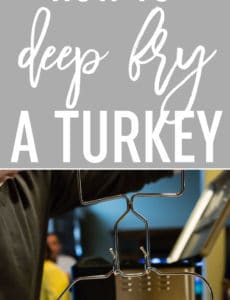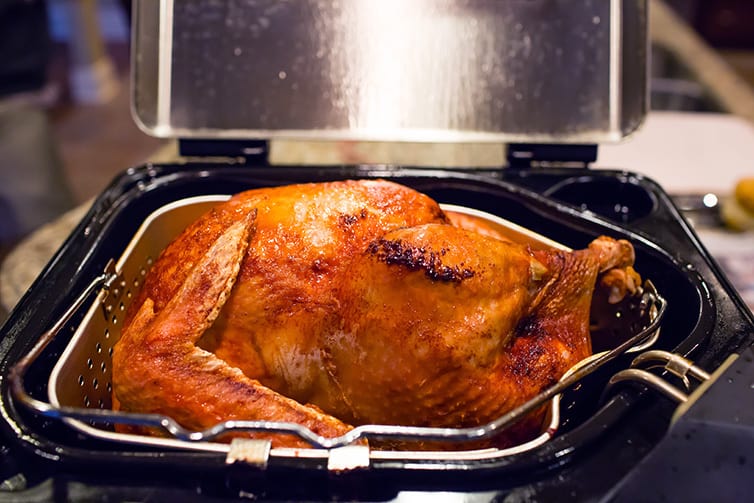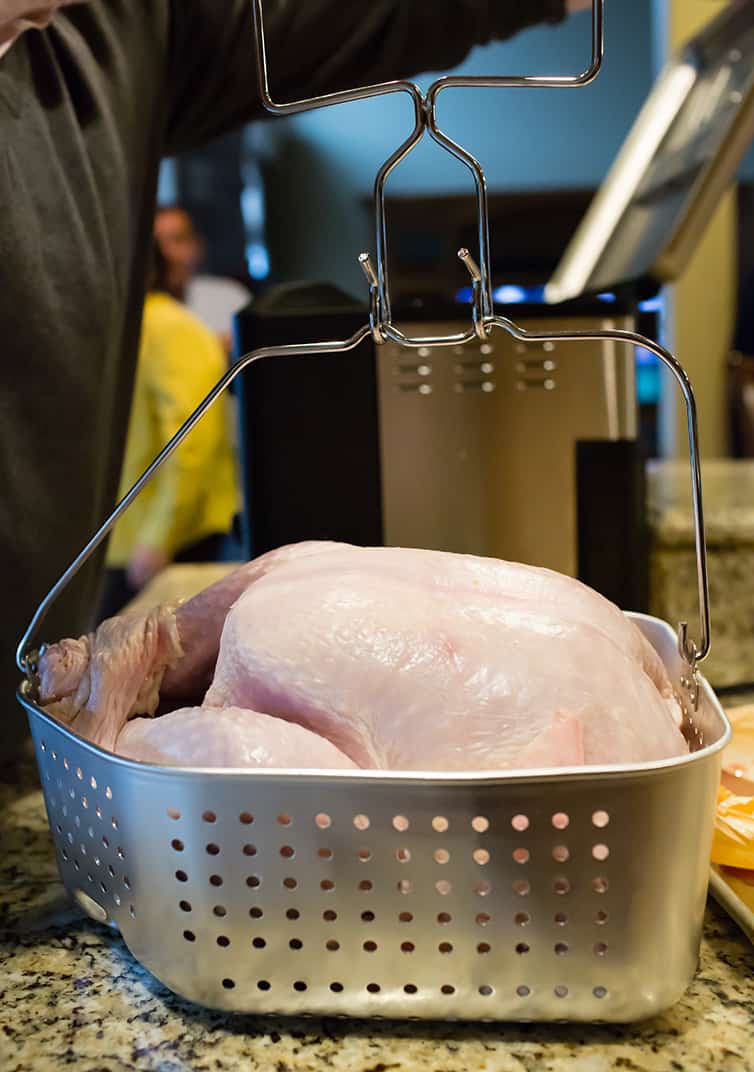How To Deep Fry a Turkey
This is a comprehensive post on everything you’ve always wondered about how to deep fry a turkey. We’ve been doing it in our family for a number of years now and I often get questions about it, so I wanted to share everything about what we use, how we use it, and tons of tips so you can do it, too!
Until a handful of years ago, I had never encountered a turkey made any other way than roasted in the oven. It’s the only way my grandma or anyone else in my family had ever done it. I heard here or there about frying a turkey, but never gave it a second thought.
When I started dating my husband, he introduced me to the tradition of deep-frying a turkey at his aunt and uncle’s house. They had an outdoor fryer, and the guys would bundle up and stand outside of the garage while the turkey cooked. I had that deep fried turkey a time or two and it was amazing! However, never did I actually think about frying one MYSELF.
Fast forward a few years, and now I can’t imagine doing it any other way!
What Kind of Deep Fryer Do You Use?
Back in 2012, my husband and I were watching a morning talk show in mid-November and they were talking about Thanksgiving dinners. One of the products they featured was an INDOOR turkey fryer. Mind. Blown. No risk of explosions and a heck of a lot safer… I scurried over to Amazon and ordered one immediately. We were having Thanksgiving dinner at my mom’s house that year, so I informed her we were going to fry the turkey, ha!
This is the turkey fryer we use: Butterball XL Electric Fryer
You can fry up to a 20-pound turkey, but we’ve definitely pushed the limits with a 24-pound turkey a couple of years ago.
How Long Does It Take to Deep Fry a Turkey?
This is one of the biggest advantages of deep frying a turkey! It takes so much less time than roasting a turkey in the oven. You’ll want to follow the instructions of the fryer you use; ours recommends three to four minutes per pound. That means if you have a 20-pound turkey (that’s the size we’ve used the last two years), it will take approximately 1 hour to 1 hour 20 minutes to finish cooking (versus like 4 hours in the oven!). We sometimes pull the turkey out, check the temperature, then need to lower it back in for a little longer, but I always err on checking at the earliest time so as not to overcook it.
We kind of make it a little event on Thanksgiving… since it doesn’t take a long time to cook, once everyone arrives, we “drop the turkey!” into the fryer, then we munch on appetizers and visit while the turkey cooks. Another bonus of frying is that the oven is completely free for side dishes!
What is the Best Oil for Deep Frying a Turkey?
We did a lot of research on this the first time we fried the turkey, and found that peanut oil is pretty much the gold standard when it comes to turkey frying oil. (Spoiler Alert: It’s crazy expensive, but we found it semi-reasonably priced at Sam’s Club.) We used peanut oil up until two years ago when Joseph was diagnosed with his peanut allergy, and then we switched to canola oil.
Canola oil has worked well for us, and we haven’t noticed any negative effects from switching from peanut oil.
Do you Brine or Use a Rub on a Deep Fried Turkey?
When we were roasting turkeys in the oven, I always brined them so I continued to do so for at least three years after we started deep-frying the turkey. In the past I had used Alton Brown’s brine for a deep-fried turkey, as well as a maple bourbon brine that Jessica shared a few years ago. Fast forward to last year when I had a 6-week old and was recovering from a c-section come Thanksgiving (which meant I wasn’t even allowed to LIFT the turkey) … and I did the BARE MINIMUM. Which meant no brine. And guess what? No one could tell the difference! SO… I’m cutting myself some slack and eliminating work that doesn’t have much affect on the final product.
I do think brines are vital when you’re roasting a turkey – they really help to seal in moisture and guarantee a juicy turkey; however, when frying, you’re getting a super moist turkey anyway!
I haven’t done a rub as of yet on a deep fried turkey, but I’m thinking about trying one this year, just for a smidge more seasoning. If I do it, I’ll let you know how we like it!
But How Do You Make Gravy If There Are No Drippings?!
Easy! I use recipes that don’t require drippings. In the past, I’ve made this Ina Garten make-ahead gravy, and more recently have made Jessica’s cider bourbon gravy, which uses the turkey neck for great flavor. There are tons of make-ahead gravy recipes online, so you could definitely find one that suits your taste preference!
Additional Tips for Deep Frying a Turkey
I covered the big questions most people have when it comes to deep frying a turkey (which one to use, how long does it take, what kind of oil do I need, and do you need to use a brine), but I do have a few other tips for you to ensure deep fried turkey success:
- Make sure you remove the neck and giblets, and do NOT stuff the turkey that you’re frying – you’re going to have to make your stuffing separately if you’re used to cooking it inside the bird.
- The turkey needs to be bone dry before you drop it into the oil to avoid splatter. In the past I have just gone to town with paper towels, but this year I’m thinking of actually doing that the night before, and then placing the dried-off turkey in the refrigerator overnight, which I’ve read helps to really ensure a super crisp skin. We usually get that anyway with frying, but no one will complain about crispy skin!
- Put the fryer somewhere safe where little hands can’t touch it… we use the end of our long island to set it up.
- Make sure whoever is dropping the turkey into the fryer has steady hands… this job always goes to my husband. He wears long oven mitts (I love these) and safety glasses as well, just in case there are splatters. He uses a large step stool to make sure he can easily lift the basket with the turkey (remember, a 20-pound turkey in a basket that’s teetering because the weight of a turkey isn’t able to be distributed evenly) up and into the fryer.
- Drop the turkey slowly, slowly, slowly. If you drop it in too quickly, you’ll get a surge and splatter of oil. Lowering it slowly reduces the likelihood that any oil is going to splash up.
Do you deep fry a turkey? If so, feel free to share any of your tips or something I may have missed below!
Five years ago: Cloverleaf Dinner Rolls
Six years ago: Cranberry Upside-Down Cake








Hello!
I follow your recipes and they are delightful! Now I have a question, what is the brand of your electric appliance fryer. Thank you
Do you season the Turkey inside and out before putting it in the fryer?
I am so sorry to bother you, but your post gives me confidence to try deep frying our turkey this year. I have two questions. 1) about how much oil do you typically use for the size of fryer you have and 2) what brand of oil do you use? I want to be as well prepared for success as I can and really appreciate your help!
I have fried Turkey’s for as long as I can remember. When I first started it was with the big pot over a propane fire. A few years back I actually won an indoor Turkey fried from a radio station contest. I can only do up to 13lbs but I would never go back, it is so much safer. I like to inject mine with injectable marinades and then put a dry rub on, it makes so much of a difference. Thanks
Here’s a tip from the guy on QVC. Be sure to dip your basket in the oil before adding the turkey.
This will insure that the turkey does not stick to the basket when removing the it.
We want to try frying a turkey this year so I was so glad to see this linked in your last post! My question is about the oil, you mention that it can be resused. How do you collect it/clean it/store it and for how long is it good for? We would probably fry one for Thanksgiving and then again at Christmas. Do you think the oil will be ok? Thank you!!
Hi Jaime, The fryer we use has a valve to drain the oil so it’s easy to put a container right underneath it and drain right back in there. You can strain it if you’d like, or leave the turkey bits in there for flavor :) Saving it from Thanksgiving until Christmas would be fine, we’ve done that! I store it in the pantry (anywhere cool/dry is fine).
Thanks to your post, I finally decided to try deep fried turkey and I went to buy the fryer. My siblings will either be out of town or working on Thanksgiving, so we had our thanksgiving dinner today. The turkey came out great, just like you described ! Thank you for posting .
Just bough th efe yer yesterday and we are so excited to try this. Only question I have Osbaldo if you season the turkey? Salt and pepper? Or any marinate?
Hi Jessica, I have brined before, and I linked to two of my favorites above. That adds flavor and moisture. Yes, salt and pepper for sure!
After frying your turkey what do you do with all that oil???
The fryer has a valve to drain the oil and we’ll usually drain it back into a large container to reuse.
I always make my gravy using the drippings from the roasted turkey, how do you make your gravy if you deep fry?
Hi Kristen, I’ve gone back and added a section above (so sorry I missed that piece!), but I just use recipes that don’t require drippings. In the past, I’ve made this Ina Garten make-ahead gravy, and more recently have made Jessica’s cider bourbon gravy, which uses the turkey neck, and is probably my favorite.
I’ve always brined our turkey before deep frying it so I am thrilled to hear you didn’t notice a difference! My question then is how do you season the turkey? If you salt the outside and inside before lowering into the oil, wouldn’t the salt fall off? Do you season it when it comes out?
Honestly, last year, we didn’t do anything and I was worried but it was still DELICIOUS. Thinking about a rub this year though!
How strong is the odor from frying inside your house? Last year we fried a turkey in our Butterball XL electric fryer in a blend of peanut and vegetable oil sold by LouAna. We cooked it in our garage and the odor was so so strong. I can’t imagine anyone doing this in their house. If you fry in 100% peanut oil is odor much less of a problem? I’d love to hear from anyone who’s fried inside! Thank you!!!
Hi Heather, I don’t think there’s a bad odor at all. We have only done it inside for the last five years and have never had an issue with odor. This coming from someone whose Italian family does the whole seven fishes on Christmas Eve and I feel like I need to burn my clothes after I leave, ha!
Good to know! Thank you, Michelle! And your seven fishes comment is making me laugh. :)
What difference do you think the oils made? Was the peanut oil a game changer? I know you had to change for allergies but would you have continued to use the peanut oil? Thanks, I’m trying to convince my husband to try a fried turkey this year! It would be so nice to have a freed up oven and not basting constantly. My biggest concern would be the gravy. Happy Thanksgiving!
Hi Kaleigh, The biggest issue is making sure you have an oil with a high smoke point, and peanut oil is pretty much the gold standard as far as that goes. We would have continued to use it; it’s the best oil to use for deep frying, but we’ve gotten great results using canola as well! (Oh and I added a section above about gravy, totally forgot!)
My husband cooks a fried turkey every year as well and we love it! So juicy, moist and crispy! Plus it gets the guys (and the messy oil business) outside. When you don’t have much counter space the outside fryers are great and inexpensive. We usually rub the turkey with cajun seasoning, sometimes we inject it with flavorings – but either way they always turn out delicious! Can’t wait for our fried turkey this year!
Michelle I feel exactly the same as you about a deep fried turkey! This year will be our fourth Thanksgiving with a deep fried turkey. Now we won’t make it any other way. I do inject my turkey with an injectable marinade before putting it in the fryer and it’s so good. I’ve done that every year and will definitely do it again this year. Happy Thanksgiving to you and your family!
Kristin, So happy to find another deep fried turkey lover! Where do you get the injectable marinade?
I buy it at Walmart.
I plan on doing this for the holiday this year but my big question – how do you get gravy?? Thanks!!
Hi Kate! Gah, I knew I’d forget something big! I went back and added a section above, but I just use recipes that don’t require drippings. In the past, I’ve made this Ina Garten make-ahead gravy, and more recently have made Jessica’s cider bourbon gravy, which uses the turkey neck, and is probably my favorite.
Curious as to how you make your gravy, if you deep fry the turkey.
Ahh good question, I knew I would forget something! I will add a section above, but I use recipes that don’t require drippings. In the past, I’ve made this Ina Garten make-ahead gravy, and more recently have made Jessica’s cider bourbon gravy, which uses the turkey neck.
Cooks Illustrated has a fabulous make ahead gravy as well. I like it because you roast turkey thighs or wings, vegetables at high heat in the oven first to get a great browning, then empty all of this into a large stock pot, add the recommended liquids, simmer for 1 1/2 hours, strain, skim the fat, and finish it off with the usual flour, salt, pepper. you can freeze it up to one month ahead. The recipe is titled Make Ahead Turkey Gravy, if you want to find it. We cannot get enough of it!